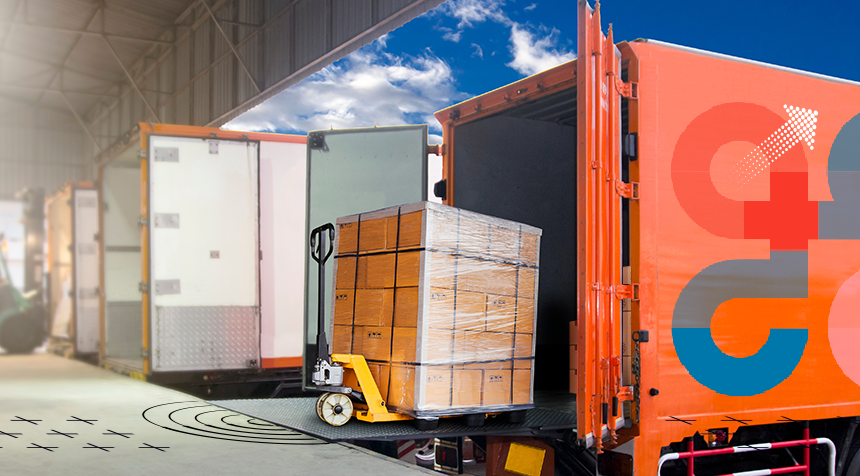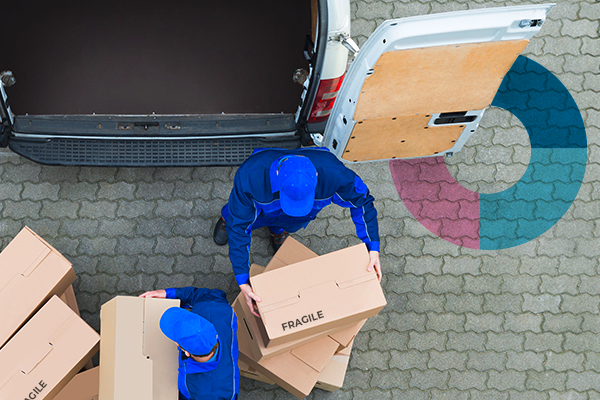Businesses that rely on freight shipping must grapple with the constant tension between moving goods as fast as possible to their destination and getting the best price to maximize profitability. Nowhere is this more apparent than having to choose between LTL shipping (less than truckload) and FTL shipping (full truckload) freight shipping.
This article unpacks the pros and cons of LTL shipments and FTL shipments, comparing each one’s strengths and weaknesses before concluding with guidelines on how to select the best shipping method according to business objectives and criteria.
What is LTL freight?
LTL shipping literally refers to “less than a truckload.” The context is that of a tractor trailer truck which typically holds up to 45,000 lbs when fully loaded, carrying a number of smaller multiple shipments which are anywhere between 150 and 15,000 lbs each. LTL shipping refers to those smaller lots which are aggregated until it equals or is a little less than a full truckload.
Since these shipments use less than the entire truck, the free space is sold to other parties resulting in a single shipment shared by two or more customers. Freight class, or National Motor Freight Classification (NMFC), is a standardized way of classifying LTL freight shipments based on certain characteristics that all figure into which shipping method can be used and the final shipping cost.
Besides sheer weight, the freight class for truckload shipments is determined by additional factors such as:
- Density – the weight per unit of volume
- Stowability – the amount of space required to show the shipment
- Handling – the amount and difficulty of transfers, loading and unloading
- Liability – the chances a shipment will be damaged or cause damage to a third party
All these parameters must be checked to make sure the shipment has the proper freight class for LTL shipping and how it affects pricing. With this understanding of LTL, let us have a look at the pros and cons of this particular freight shipping method.
Pros and cons of LTL freight shipping
Just like any other shipping method, LTL has both benefits and drawbacks. It really depends on what is being shipped, how quickly it has to get there and how much it costs.
The benefits of LTL shipments
One of the biggest benefits of LTL is sharing space and shipping costs with other customers. Using LTL shipping, each party is paying part of the overhead, making the price paid by each party significantly lower than other freight shipping methods.
There are also other advantages such as the use of palettes for protection against damage and the flexibility of assembling shipments consisting of multiple sizes and units. Likewise, it enables access to special services including inside pickup and liftgates.
The drawbacks of LTL shipments
LTL has potential disadvantages as well. It only allows shipping suitable for large packages that exceed parcel size but are less than a full truckload. For those shipping smaller items, very heavy items or very bulky items, alternate truckload shipping methods may be required. Another potential drawback are the surcharges and service fees that may offset some of those attractive LTL rates.
It is also important to understand that LTL is not the most profitable option for freight carriers compared to full truckload shipping. LTL shipping means drivers must stop at multiple touch points, and in certain cases even add on extra drop-off points. In terms of costs, this translates into extra loading and staging time, more fuel consumption and higher pay scales for drivers when compared to shipping methods like FTL.
What is FTL shipping?
FTL refers to a “full truckload” of freight. In the physical world, this means taking up most of the 424 sq ft of storage available on a typical 8 x 53 ft semi-trailer. Even if the actual shipment is 75% or 95% of the available capacity, the consignor still pays for a full load. In general, FTL shipping is much less restricted by regulations regarding size and weight restrictions when compared to other shipping methods.
The decision of how much of the entire truck should be loaded is really a business decision depending on delivery and cost considerations. As opposed to LTL, there are no delays due to waiting for multiple customers to get their products to the FTL shipper. Since there is no sharing, the LTL carrier can start the shipping process as soon as the rig is loaded.
FTL shipping is used for large shipments that require most of the truck, which means there are no extra stops along the way. With FTL the entire truck belongs to a single customer that has full control over staging, loading and routing. As compared to the many stops and excessive handling for LTL, this ensures less damaged goods and faster delivery due to ownership of the entire process by a single entity.
Pros and cons of FTL shipping
Now that we have a better understanding of FTL, let us try and take an objective look at the benefits and drawbacks of FTL freight shipping. The purpose is to get a better understanding of FTL carriers, which in the end of the day helps make better decisions regarding which delivery method should be used in a particular situation.
The benefits of FTL shipments
The most important advantage of FTL is quicker delivery as there is no need to share the truck with other customers. Foremost of these advantages is the elimination of waiting time for multiple shipments until there is a full truckload. Other benefits include less staging, loading and unloading, resulting in faster delivery times and better protection of goods from damage due to excessive handling.
In commercial terms, quotes from LTL carriers are usually quicker and more accurate than other methods. Many locations even offer fixed pricing for FTL shipping with few weight and size restrictions.
FTL is especially cost-effective for shipping in bulk, large shipments and in some cases high-value goods. It is also easier to track due to the simplified logistics of a single point to point shipment.
The drawbacks of FTL shipments
In terms of drawbacks, it should be clear that shipping FTL is not the most cost-effective shipping method for customers with less than a certain quantity of goods. FTL carriers do not provide a lot or value added services and are less flexible when it comes to adding stops, alternate routes or other last minute changes that seem so common these days.
FTL is not a solution for small volume shipments and coupled with today’s acute shortage of long haul drivers, does not seem like it will be competitive with LTL in terms of price performance under 15,000 lbs in the near term.
Using LTL and FTL according to business objectives
From our investigation, it seems there are specific times when one should use LTL and other circumstances where FTL makes more sense. It really depends on business objectives. If a certain shipment must arrive in a week, then one might consider FTL shipping even if it is not cost effective. On the other hand, if a product has a low value, then there is no business justification in paying such a high percentage of the product value in shipping costs.
LTL shipments are relatively small, ranging from 100-5000 lbs. These smaller lots will not fill an entire truck, leaving space to sell to other customers that want to join the shipment. With FTL a single shipment fills 80-100% of an entire truck, which means they should have a minimum weight of 36,000 lbs.
The biggest difference between LTL and FTL is the cost. Even though one is actually paying more per sq ft using LTL, it actually comes out much more cost effective than FTL shipping. How is this possible?
It is actually quite simple. Let us say the cost for FTL shipping is $1 per lb while the cost of LTL shipping is $5 per lb. That is quite a difference. But considering the load is only 100 lbs, then the cost of LTL shipping comes to a total of $500.
When compared to FTL, the price might seem cheaper at $100 for a 100 lb load, but if one is required to take the entire truck and its 45,000 lb capacity, then it ends up costing a whopping $45,000 for delivery of a 10 lb shipment! Please note that for the sake of simplicity, many real-life factors such as density, stowability and other variables that factor into freight class definitions and shipping costs, were not considered in this example.
Although there are no hard fast rules in choosing between LTL and FTL, the table below is meant as a guide for selecting the best shipping method in each situation.
| Criteria | LTL | FTL | Notes |
|---|---|---|---|
| Shipping more than 15 palettes / 15,000 lbs | No | Yes | FTL is not economical at less than 15 palettes or 15,000 lbs |
| Protective packaging / Durable products | Yes | Yes | Protective packaging is recommended for LTL |
| Standard packaging / Fragile products | No | Yes | FTL is better for fragile products due to the excessive handling on most LTL shipments |
| Time sensitive delivery | No | Yes | FTL means one driver, one delivery route and fastest time to destination |
| Price sensitive delivery | Yes | No | LTL prices are low due to cost sharing, while FTL requires paying for a full truckload |
For freight shipments of 15 pallets / 15,000 Ibs or more, one should consider FTL shipping. While in theory FTL offers security, speed, and performance, when selecting the right freight shipping brokers and partners are also key in making sure goods reach their destination on time and on budget.
FTL is also a good choice for importers with sensitive or valuable goods. Special trucks can be tailored to each importer’s needs without having to worry about multiple shipments and shared space LTL partners.
It is important to be aware of how likely products are to incur damage during shipment. They should be sturdy enough for regular handling at various points throughout the shipping process or have protective packaging to prevent damage from excessive handling.
For fragile products, avoiding excessive loading and unloading by multiple carriers is essential. That is why the FTL option makes the most sense, as all the fragile products are shipped from the same source and can be packaged, stored, routed and handled according to customer specifications.
Firm delivery and pick-up dates work better with the FTL option. This is because the very nature of LTL is waiting for other customers to fill up shared space, meaning there is no concrete timetable for when that will happen. If volume is small and delivery time is not critical then LTL is probably the preferred shipping method.
In a nutshell, LTL is really about cost savings provided that the shipment is substantially less than a full truckload. One must take into account, however, that lower costs require increased flexibility with regard to shipping and delivery dates. In such cases, it is recommended to provide a pickup and delivery range to consignees, as opposed to specific delivery schedules which may vary in reality.
Conclusion: transforming the conversation
In facing today’s logistics challenges, it does not make sense to continue arguing about LTL vs FTL. This needs to transform into a more objective conversation about both LTL and FTL shipping methods and how each one should be leveraged to achieve business goals.
Even with a good understanding of LTL and FTL shipment methods, management of freight shipping and last-mile delivery remain challenging for many online businesses. Why not reach out to the experts at Bringg and start that conversation about improving your delivery and fulfillment performance while increasing customer satisfaction. We will be glad to tell you more.




